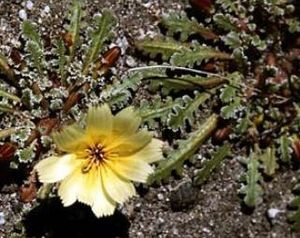Glyptopleura facts for kids
Quick facts for kids Glyptopleura |
|
|---|---|
 |
|
| Glyptopleura marginata | |
| Scientific classification | |
| Kingdom: | |
| (unranked): | |
| (unranked): | |
| (unranked): | |
| Order: | |
| Family: | |
| Tribe: |
Cichorieae
|
| Subtribe: |
Microseridinae
|
| Genus: |
Glyptopleura
D.C.Eaton
|
| Type species | |
| Glyptopleura marginata D.C.Eaton
|
|
Glyptopleura is a small group of plants found in North America. They belong to the dandelion family, which includes many common flowers like sunflowers and daisies. People sometimes call these plants carveseed, holy dandelion, keysia, or crustleaf.
What Does Glyptopleura Look Like?
These interesting plants grow close to the ground. They have a flat cluster of leaves at their base, called a basal rosette. Their green leaves have unique shapes, with lobes and a noticeable hard white border. If you break a leaf, you'll see a milky sap inside.
The flowers of Glyptopleura are special. They have long, strap-shaped petals, called ray florets, that have tiny teeth at their ends. These flowers can be white, cream, or a pale yellow color.
Where Do Glyptopleura Plants Grow?
There are two main types of Glyptopleura plants. Both are found in the western parts of the United States:
- Glyptopleura marginata is found in California, Nevada, Utah, Oregon, and Idaho.
- Glyptopleura setulosa grows in California, Nevada, Utah, and Arizona.
See also
 In Spanish: Glyptopleura para niños
In Spanish: Glyptopleura para niños

